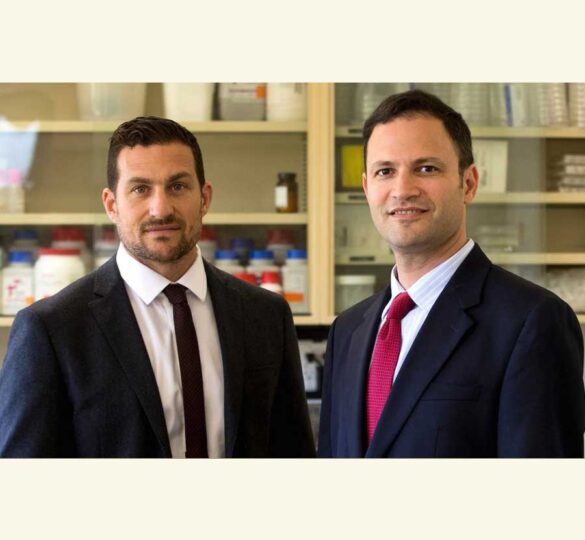Catalyst for a Cure Biomarker Initiative: A Game Changer in the Fight to Protect Vision
“Two clinical trials are underway for vision restoration,” says Dr. Huberman. “These trials would not be possible without the identification of new biomarkers.”

Key to helping prevent irrevocable vision loss from glaucoma is early detection combined with effective treatment. But to date, mechanisms to evaluate the progression of glaucoma have been limited.
Now investigators with the Catalyst for a Cure (CFC2) Biomarker Initiative are on the verge of upending this barrier through the identification of new biological markers for glaucoma. Biomarkers can provide physicians with better tools to diagnose and manage glaucoma before vision is lost, as well as accelerate the pace of discovery toward better treatments and ultimately a cure for glaucoma.
A Unique Collaborative Approach
Setting the agenda for glaucoma research, Glaucoma Research Foundation established the CFC Biomarker Initiative in 2012. The consortium builds on the success of the first CFC initiative and harnesses the abilities of four investigators — Alfredo Dubra, PhD, Jeffrey L. Goldberg, MD, PhD, Andrew G. Huberman, PhD, and Vivek Srinivasan, PhD — who were tasked with finding biomarkers for glaucoma.
The four researchers, working in laboratories at prestigious academic centers, bring expertise in disciplines ranging from biomedical imaging, physics, retinal cell biology, and neurobiology to clinical ophthalmology. “The principle is team science,” explains Dr. Goldberg, “with the intent of discovering fundamental biology, implementing it in innovative engineering, and pushing it from the laboratory into the clinic.”
A Critical Tipping Point
Thanks to the CFC Biomarker Initiative, identification of molecular biomarkers for glaucoma has greatly accelerated. The CFC investigators have made extraordinary progress in speeding the progress of investigation, and they are now at a critical tipping point.
Motivated by the hypothesis that structural and/or metabolic changes in the retina will allow eye doctors to detect and monitor glaucoma and evaluate treatment efficacy, the researchers focused their attention on the retinal ganglion cells (RGCs). The health and evaluation of the RGCs are fundamental to glaucoma, because as RGCs degenerate and die, vision is lost.
Through their investigations, the researchers identified which types of RGCs are injured or die first in glaucoma. Then the team developed state-of-the-art imaging equipment to noninvasively measure structural and biological changes in the RGCs.
With the aid of the diagnostic tools they created, the researchers have identified biomarkers that may be among the earliest to show changes in glaucoma.
The CFC team now has eight potential new biomarkers and they are focusing on three of the most promising:
- Mitochondrial structure and metabolism — Mitochondria that are damaged or not working correctly can result in the damage and eventual death of RGCs. By observing and measuring changes to the mitochondria, it may be possible to help ensure the health of the RGCs before vision is lost.
- Retinal oxygen metabolism — Changes in oxygen saturation can be harmful to the eye and may play a role in glaucoma. Specialized equipment developed by the team can be used in the clinic to measure changes in oxygen saturation to diagnose and monitor glaucoma more effectively.
- Imaging of the inner retina — Being able to view early changes in the retina’s vascular, nerve fiber, and ganglion cell components could allow doctors to step in before the nerve cells are damaged.
Faster Drug Discovery and Personalized Treatment
Based on the investigators’ findings, the implications for treatment are profound. In addition to allowing doctors to intervene before the nerve cells are damaged, biomarkers can lead to faster drug discovery by quickly demonstrating efficacy, and they hold promise of helping eye doctors provide personalized treatment specific to each patient’s diagnosis.
Functional tests for these new biomarkers have been validated in models of glaucoma and are now being tested in patients. “The researchers’ ability to bridge from laboratory studies to human studies, and now take that into the clinic, is what we set out to do six years ago,” says Dr. Huberman.
On the Horizon: Vision Restoration
The consortium is now focused on a bold new goal: a pathway toward a therapeutic strategy for restoring lost vision in glaucoma patients.
“Two clinical trials are underway for vision restoration,” says Dr. Huberman. “These trials would not be possible without the identification of the new biomarkers and the new imaging equipment that the team has built.”
The impact of the consortium’s work cannot be overstated: the CFC Biomarkers Initiative is on the verge of changing the future of how glaucoma is diagnosed and treated. It has the real potential to transform clinical care, and, most importantly, to change lives.
The Catalyst for a Cure Biomarker Initiative — Principal Investigators
 Alfredo Dubra, PhD
Alfredo Dubra, PhD
Associate Professor of Ophthalmology
Stanford University School of Medicine
The main goal of the Dubra lab is to develop non-invasive optical imaging methods for early detection and monitoring of eye disease. The lab pursues a multidisciplinary approach, with a major focus on translating techniques and analytical tools from physics, astronomy and mathematics into robust quantitative diagnostic tools.
 Jeffrey L. Goldberg, MD, PhD
Jeffrey L. Goldberg, MD, PhD
Professor and Chair, Department of Ophthalmology
Stanford University School of Medicine
Dr. Goldberg’s research is directed at neuroprotection and regeneration of retinal ganglion cells and other retinal neurons. His laboratory is developing novel stem cell and nanotherapeutics approaches for ocular repair, studying retinal ganglion cell development, survival and axon regeneration in glaucoma, and investigating the cellular basis for the developmental loss of axon growth ability.
 Andrew D. Huberman, PhD
Andrew D. Huberman, PhD
Associate Professor, Departments of Neurobiology and Ophthalmology
Stanford University School of Medicine
The purpose of the Huberman laboratory is to research and understand how the retinal and brain circuits that underlie vision wire up during development and to develop new strategies to monitor, prevent, and treat retinal ganglion cell loss in glaucoma. Dr. Huberman is a neuroscientist who has made many contributions to the brain development, brain plasticity, and neural regeneration and repair fields.
 Vivek Srinivasan, PhD
Vivek Srinivasan, PhD
Associate Professor of Biomedical Engineering, Ophthalmology & Vision Science, and Chancellor’s Fellow, University of California, Davis
Department of Biomedical Engineering, Davis, California
The Srinivasan Biophotonics Laboratory develops novel optical imaging techniques and diagnostics with applications spanning from basic to clinical research. In particular, the lab is interested in neuronal control of hemodynamics and metabolism both in health and disease in the central nervous system, including the retina and brain. Their highly interdisciplinary approach combines cutting edge imaging technologies with collaborations ranging from neurobiology to neurology and ophthalmology to test fundamental hypotheses and explore the diagnostic implications.
First posted on May 3, 2017; Last reviewed on May 16, 2022